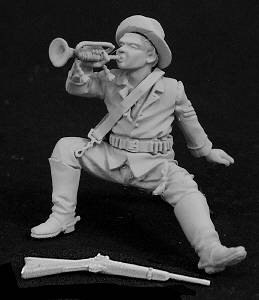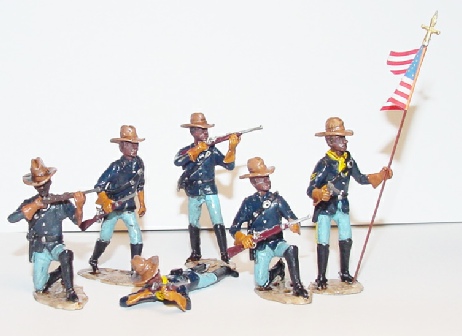 Frankly, I don’t get re-enactors. Like that overweight, redneck Civil War buff I saw years back, firing his musket, then yelling at advancing Yankee re-enactors: “Eat [bleep] and die!” I can’t see a Reb in 1863 being so plump.
Frankly, I don’t get re-enactors. Like that overweight, redneck Civil War buff I saw years back, firing his musket, then yelling at advancing Yankee re-enactors: “Eat [bleep] and die!” I can’t see a Reb in 1863 being so plump.
These guys, however, I understand and like. But they’re not “re-enactors.”
Lieutenant Henry O. Flipper greets me at the San Antonio National Cemetery. You probably know Flipper, the first black graduate from West Point. Born into slavery in Georgia in 1856, Flipper was commissioned as a second lieutenant in 1877 and served in the 10th Cavalry, including the campaign against Victorio’s Apaches. Court-martialed in 1881, he was dishonorably discharged, but in 1999, President Bill Clinton gave Flipper a posthumous pardon.
Actually, Flipper is Turner McGarity, a member of the Bexar County Buffalo Soldiers Association, dedicated to honoring the black soldiers and Seminole-Negro Indian Scouts who served in the post-Civil War West. Eighteen earned the Medal of Honor.

Just don’t call these men “re-enactors.”
“We’re not a re-enacting group,” McGarity says. “We spread history that has been left out of the books.”
The “Buffalo Soldiers” Begin

The post-Civil War history of the “Buffalo Soldiers” began on July 28, 1866, when Congress authorized the formation of six all-black regiments (two cavalry, four infantry), the first black regiments created since the Civil War, which saw 175 such regiments in the Union Army. Those six units would be reduced to four regiments, the 9th and 10th Cavalries, and the 24th and 25th Infantries, history’s “buffalo soldiers.” Most of the 9th, organized in New Orleans, would train in San Antonio. The 10th would set up shop in Fort Leavenworth, Kansas.
The latter’s as good a place as any to start this trip.
That’s because the Frontier Army Museum tells the story of the Army (1804-1916) and the fort (1827-today), and its collection of horse-drawn vehicles is considered among the world’s best. Buffalo Soldier Memorial Park, dedicated in 1992, is beautiful, inspirational and educational.
Entry to the museum and memorial is free, but photo identification is required for entrance to the still-active fort.
Benjamin Grierson commanded the 10th. Edward Hatch commanded the 9th. Not all officers welcomed the opportunity to command blacks—many of whom were recently freed slaves. George Custer rejected a lieutenant colonel’s commission in a black regiment (he got one, instead, in the all-white 7th). Frederick Benteen decided he’d rather be a captain in the 7th than a major in the 9th. On the other hand, Wesley Merritt became the 9th’s lieutenant colonel before being promoted to the 5th Cavalry’s command in...
No comments:
Post a Comment